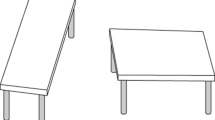Abstract
David Lewis’s ‘Humean Supervenience’ (henceforth ‘HS’) combines realism about laws, chances, and dispositions with a sparse ontology according to which everything supervenes on the overall spatiotemporal distribution of non-dispositional properties (Lewis 1986a, Philosophical papers: Volume II, pp. ix–xvii, New York: Oxford Univesity Press, 1994, Mind 103:473–490). HS faces a serious problem—a “big bad bug” (Lewis 1986a, p. xiv): it contradicts the Principal Principle, a seemingly obvious norm of rational credence. Two authors have tried to rescue Lewis’s ontology from the ‘big bad bug’ (henceforth ‘the Bug’) by rejecting realism about laws, chances, and dispositions (Halpin 1994, Aust J Phil 72:317–338, 1998, Phil Sci 65:349–360; Ward 2005, Phil Sci 71:241–261). I will argue that this strategy cannot possibly work: it is the ontology, not the realist thesis, that lies at the root of the problem.
Similar content being viewed by others
References
Bigelow J., Collins J., Pargetter R. (1993). The big bad bug: What are the Humean’s chances?. The British Journal for the Philosophy of Science 44, 443–462
Blackburn S. (1993a). How to be an ethical anti-realist. In: Blackburn S. (ed). Essays in quasi-realism. New York, Oxford University Press, pp. 166–181
Blackburn S. (1993b). Attitudes and contents. In: Blackburn S. (ed). Essays in quasi-realism. New York, Oxford University Press, pp. 182–197
Earman J., Roberts J. (2005). Contact with the nomic: A challenge for Deniers of Humean Supervenience about laws of nature part II: The epistemological argument for Humean Supervenience. Philosophy and Phenomenological Research 71, 253–286
van Fraassen B. (1983). Calibration: A frequency justification for personal probability. In: Cohen R.S., Laudan L. (eds). Physics, philosophy and psychoanalysis. Boston, Dordrecht, pp. 295–319
Gibbard A. (1990). Wise choices, apt feelings. Cambridge, MA, Harvard University Press
Halpin J. (1994). Legitimizing chance: The best-system approach to probabilistic laws in physical theory. Australasian Journal of Philosophy 72, 317–338
Halpin J. (1998). Lewis, Thau, and Hall on the Best-system account of chance and law. Philosophy of Science 65, 349–360
Lewis D.K. (1986a). Introduction. In: Lewis D.K. (ed). Philosophical papers: Vol. II. New York, Oxford Univesity Press, pp. ix–xvii
Lewis D.K. (1986b). A subjectivist’s guide to objective chance. In: Lewis D.K. (ed). Philosophical papers: Vol. II. New York, Oxford Univesity Press, pp. 83–132
Lewis D.K. (1994). Humean Supervenience debugged. Mind 103, 473–490
Strevens M. (1999). Objective probability as a guide to the world. Philosophical Studies 95, 243–275
Thau M. (1994). Undermining and admissibility. Mind 103, 491–503
Ward B. (2005). Projecting chances: A Humean vindication and justification of the principal principle. Philosophy of Science 71, 241–261
Author information
Authors and Affiliations
Corresponding author
Rights and permissions
About this article
Cite this article
Briggs, R. The big bad bug bites anti-realists about chance. Synthese 167, 81–92 (2009). https://doi.org/10.1007/s11229-007-9290-6
Received:
Accepted:
Published:
Issue Date:
DOI: https://doi.org/10.1007/s11229-007-9290-6



